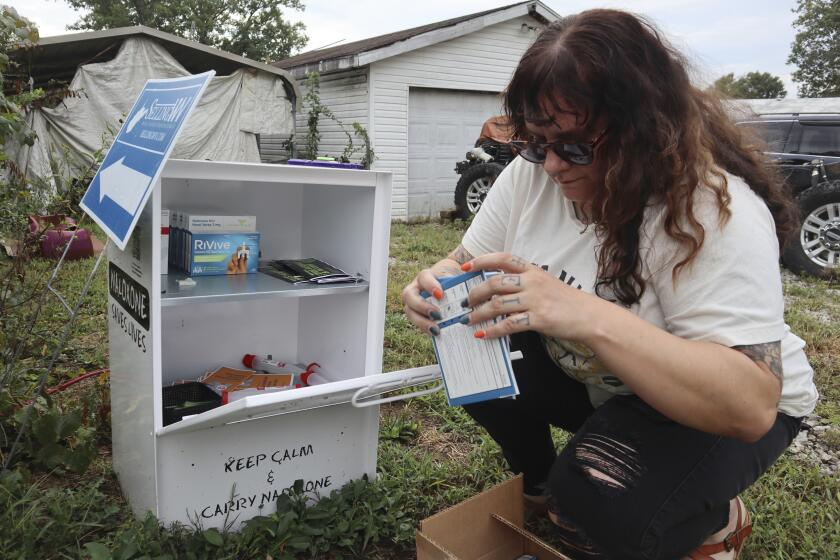Computer Chaos Slows the Pursuit of Deadbeats
It is a source of pride in the Ventura County district attorney’s office, a force of 270 people that year after year tracks down hundreds of deadbeat parents and makes them pay up.
Their aggressive collection efforts helped increase the caseload from 8,000 to 36,000 over the past decade. Their hard work won the agency incentive pay. Colleagues called from across the state to seek advice on collecting child support.
But a well-intentioned federal law requiring all counties to have automated, integrated computer systems by October has thrown a monkey wrench into the machinery of the D.A.’s Child Support Division, sharply hampering the agency’s ability to garnish wages from absentee parents and distribute checks to the families who need them, officials say.
Since Ventura County’s version of the State Automated Child Support System went online in November, child-support employees have seen accounting records thrown into disarray.
Some child-support officers find themselves trolling through a maze of computer screens just to answer the most basic questions for confused and angry recipients: who paid what, when, and where the money went.
Over the past seven months, hundreds of checks have been lost in the system or have been sent with inaccurate payment amounts. One client even called wondering why the county mailed a check for 1 cent.
At times, it has taken days rather than minutes to generate legal forms--complaints, summons forms, letters to employers of child-support deadbeats--that are crucial to gaining court orders to force child-support payments.
And part of the system designed to help track down absentee parents by tapping into large databases--such as those kept by the Franchise Tax Board and Division of Motor Vehicles--has never worked at all.
“I think somebody here should stand up and say, ‘I’m sorry, it just didn’t work,’ ” said Sylvia Izquierdo, a child-support officer who spends her days trying to answer the most difficult questions for angry recipients. “It’s too complicated.”
Ventura County had little choice but to install the new system, officials say.
Hoping to increase child-support enforcement and thus reduce welfare rolls, Congress in 1988 passed the Family Support Act. Under the threat of stiff sanctions, the act required all states to create a computer system for tracking child-support cases. California’s deadline is September--a deadline state officials estimate will be missed by as much as three years.
In 1992, the state contracted with Lockheed Corp. to design and implement the new system. The system originally was projected to cost $99 million.
Last month, with a state-hired consultant listing 1,400 glitches and with more feared to be lurking within, state officials raised the cost estimate to $305 million.
The state is now evaluating whether to continue with the program or scrap it in favor of a new system.
With nearly identical annual caseloads of 36,000 and 33,000, respectively, Ventura and San Francisco became the largest of 23 counties to sign on to the automated system last November.
By May--with its accounting records, enforcement efforts and employee morale in a shambles--San Francisco had seen enough and pulled out.
Too many children reliant on child support were seeing their monthly support checks lost, delayed or containing inaccurate payments.
Threats of state or federal sanctions didn’t matter much.
“We are saying ‘So what?’ ” said Edwina Young, director of the San Francisco Family Support Bureau. “We have to provide services. We can surely read the law that says that.”
*
It hasn’t been easy. San Francisco County has spent the last month reverting to its old system, along the way double-checking every new case opened over the previous six months and auditing every transaction, Young said.
“The things it did to our accounting records were unforgivable and so impossible to deal with,” Young said. “It really doesn’t matter who’s going to find us at fault if we’re doing our job providing services and doing it correctly.
“What it did to our employee morale was just a sin,” she added later. “The public was so upset, and [employees] are the ones on the front lines, they’re the ones who have to explain, they’re the ones who have to figure out what happened. It got them all angry and hateful and retaliatory. They accused management of everything. They wanted to hang me in effigy.”
San Francisco County was fortunate to be able to return to a former computer system that already had been completely automated and devoid of paper, she said.
But Ventura County doesn’t have that luxury, said C. Stanley Trom, director of the Ventura County Child Support Division. For Ventura County, returning to the old computer network would mean the huge cost of refinancing all of the equipment, and in the end would mark a return to an outdated system out of compliance with the federal mandate, he said.
Also, if the county pulls out, it would be responsible for financing the replacement system. But if the state decides to scrap the system, it will pay the bulk of the replacement cost, county officials said.
“If you pull the plug, how much is it going to cost and who’s going to pay?” said Gregory D. Totten, the chief deputy district attorney in charge of child-support enforcement. “We are still in a mode to try and make it work if that’s at all possible. But things need to get better soon. There has been some improvement, but we need more in the near future.”
Indeed, officials said, while daily contact with Lockheed has made for some improvement, and although 98% of the roughly $3 million the county takes in each month is redistributed without any problem, the system has created far too many headaches.
Each month, there are about 250 cases that represent about $300,000 in payments that the computer system holds up or hides in an electronic no man’s land, said Elizabeth M. Teague, supervising accountant in the child-support division.
*
In February, the agency was forced to set up a special emergency bank account to cover checks for hardship cases. At times, officials could confirm that a child-support payment had been made but not necessarily where the money had gone in the computer system.
“There are a lot of defects throwing things into ‘La La Land’ . . . and we truly don’t know why,” Teague said.
Out of the approximately $3 million in child-support checks the Child Support Division brought in last month, accountants can’t print a monthly report showing how it was distributed, she said.
“The system, from an accounting standpoint, lacks in integrity,” she said. “You can’t rely on what you think you’ve done, and you can’t rely on the printed reports you’re receiving out of the system.”
Employees have been frustrated by confusing codes, a complete lack of training manuals and multiple screens that make the opening of new cases or adjustment of old ones a job requiring hours rather than minutes.
The district attorney’s office has even found itself writing letters to landlords and creditors on behalf of child-support recipients whose payments are late.
Each day, five to 10 employees do little more than field angry phone calls from parents caught in the system’s cumbersome web.
The result of the months-long problem is perhaps most evident in the backlog of 2,600 cases that line 16 bookshelves in the unit’s Telephone Road offices in Ventura.
“I think it’s safe to say there is a lot of unhappiness among caseworkers and a lot of frustration,” said one child-support worker who spoke on condition of anonymity. “People who used to love their jobs now hate their jobs. People are wanting to do anything else rather than work here.”
Those who lead the agency say they understand the employees’ frustration. They are frustrated too.
Since the mid-1980s, the child-support collection unit had seen caseloads rise 8% to 16% annually.
The growth was as much a matter of aggressive collection efforts as it was a reflection of society: more children being born out of wedlock, increasing divorce rates and a recession that threw thousands out of work, Trom said.
*
The employees’ effective work earned the unit millions of dollars incentive pay that was put back into the support collection budget to boost enforcement even further.
But over the last two months, the once-strong growth rate has slowed to 2%.
“We’ve always taken pride in what we do,” Trom said. “That’s what makes this current situation so difficult.”
Ventura County officials are waiting for the June 9 release of a report by Logicon Inc., a computer technology analysis firm hired by the state to assess whether the system will ever work properly.
The Logicon report will pinpoint the risks, benefits and costs of alternatives to the Lockheed system, Trom said.
And in coming weeks, county officials will keep a close eye on Sacramento, where lawmakers will consider the huge spending increases Lockheed says are necessary to make the needed improvements.
Meanwhile, with its caseload numbers declining, Ventura County is working out a contingency plan of its own, assessing how much it would cost to return to its old, outdated system while the problems with the new system are ironed out.
“We are a debt collection business, and one of the things collectors do is keep after people,” Trom said. “If you leave people alone, they will say ‘They’re not after me’ and they won’t pay the bill. . . . We can’t continue to live with a deteriorating rate of collections for very long.”
More to Read
Sign up for Essential California
The most important California stories and recommendations in your inbox every morning.
You may occasionally receive promotional content from the Los Angeles Times.










